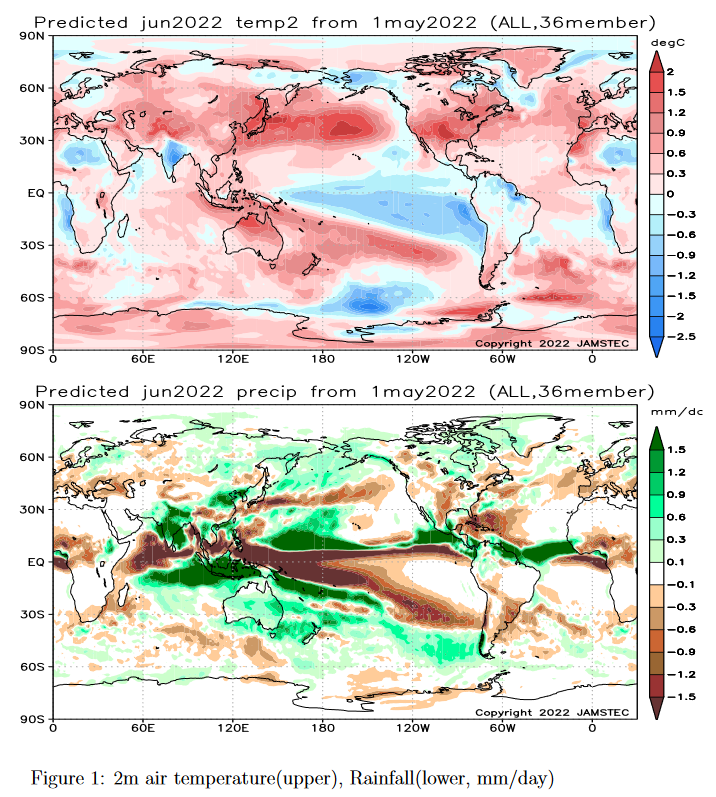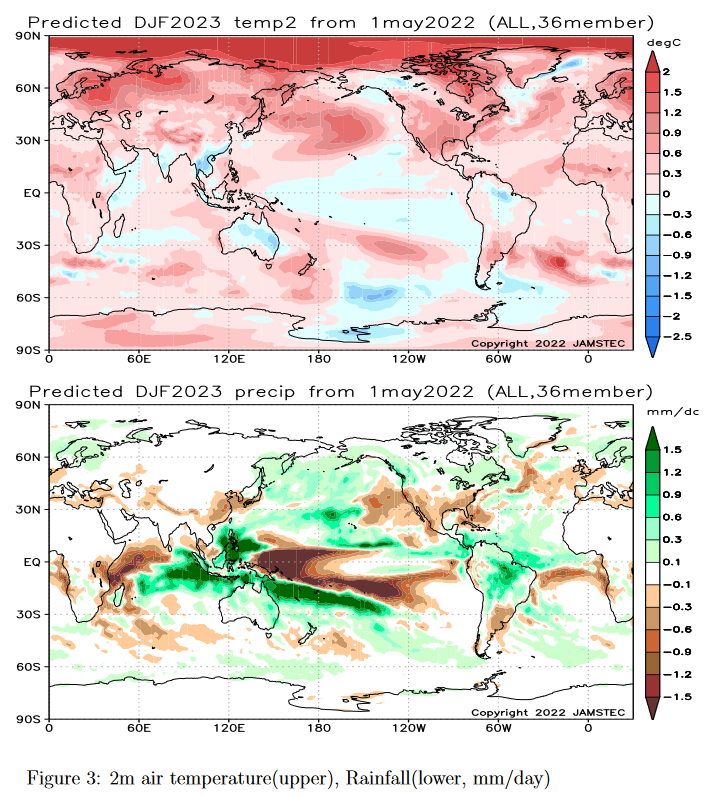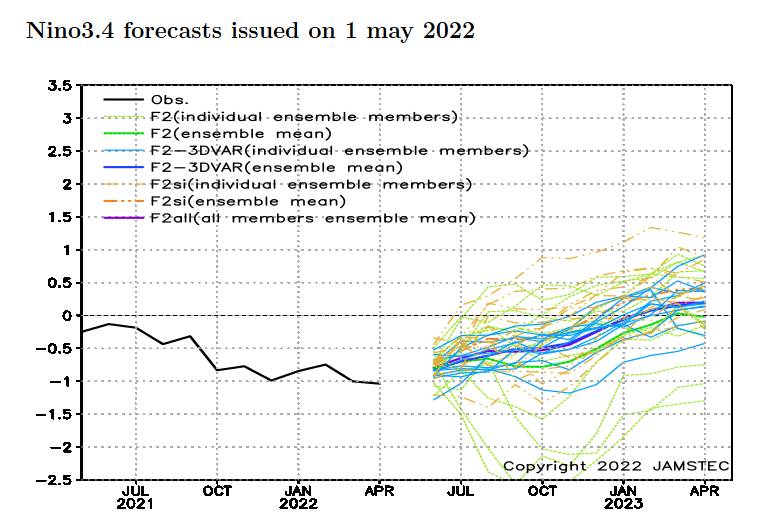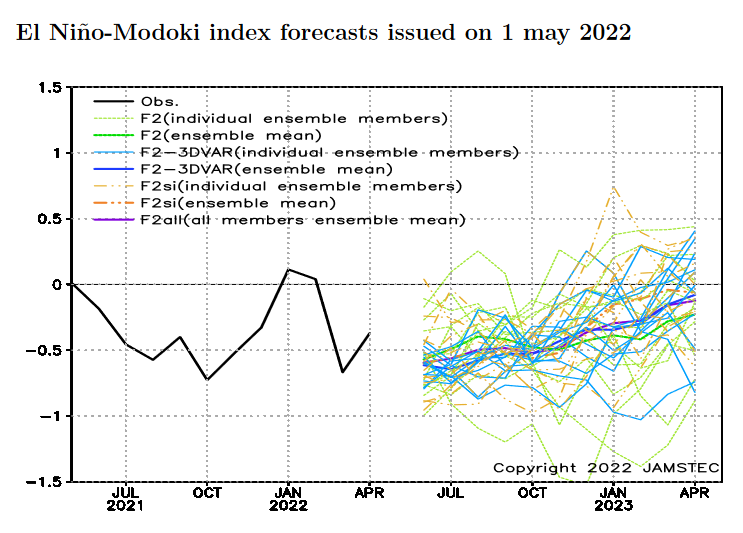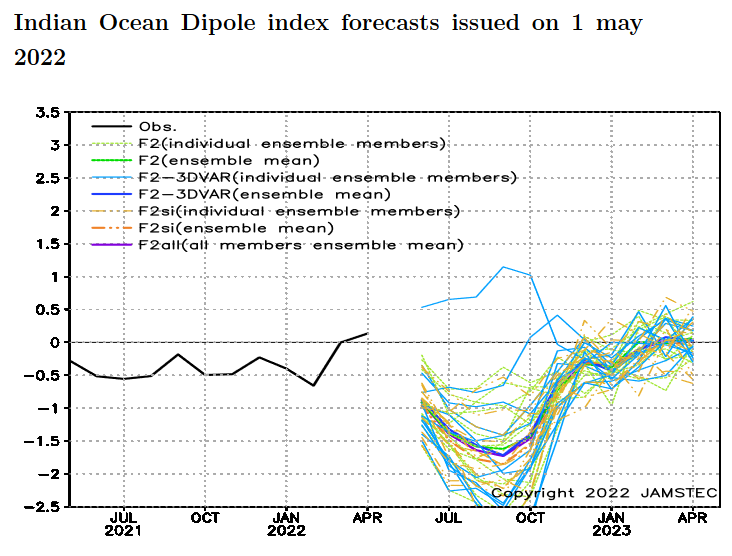Usually, I compare the JAMSTEC forecast with the NOAA forecast after NOAA Issues its Seasonal Outlook. But this month, JAMSTEC was very early so I thought I would share it with everyone now. NOAA calls their predictions an outlook but JAMSTEC calls their predictions a forecast. I am going to show the JAMSTEC forecasts by month and by season and some of the indices they use in their model. They make world forecasts and for any readers who do not realize it, the U.S. is part of the world so it is covered by a world forecast. Of the two seasons that include our monsoon, I will extract the North American forecast from their world forecast and enlarge it.
I like the JAMSTEC forecast because the U.S. is part of the world and our weather is not independent of the worldwide weather pattern. In fact, most of U.S. weather originates in the Pacific Ocean and the Pacific Ocean is where Japan is located. In fact, Japan and the US jointly manage the monitoring system along the Equator that helps predict the phases of ENSO. So one of the reasons I include worldwide forecasts in articles is to encourage the understanding of worldwide weather patterns. It is not that the U.S. does not cooperate with other nations with respect to weather forecasts as it does. But to view weather forecasts on the Internet or TV you would not easily notice that. The U.S. pays hardly any attention to what other meteorological agencies predict.
For those interested in the U.S., the forecast for the Summer Monsoon and the overall placement of the drought is of interest. We will have the NOAA forecast this Thursday and it will be interesting to see the level of agreement or disagreement.

For Introductory purposes, I will again, as I did last month, describe what JAMSTEC is
JAMSTEC | Japan Agency for Marine-Earth Science and Technology

It is not a huge organization like NOAA but it does a lot of things much of which are related to ocean research. It is not the weather forecasting agency for JAPAN but issues this worldwide forecast as part of its research program. Some information on their model can be found by clicking Here
I will begin with the three short-term monthly forecasts
First June, 2022
Then July, 2022
Then August, 2022
Then we shift to the three seasonal forecasts (these are three-month forecasts and this month they align with the meteorological definition of seasons which is a bit different than what most people are used to)
The JAMSTEC discussion below describes the first two maps. But you can look at the map and see where it is warmer or cooler than usual and drier or wetter than usual. You can do the same thing for the above three single-month maps.
First June/July/August 2022
One can interpret this map themselves but this is what JAMSTEC says about it (I extracted the information from their discussion and added some headings for clarity)
Summer Temperature
On a seasonal scale, the SINTEX-F predicts that most parts of the globe will experience a warmer-than-normal condition in boreal summer (austral winter), except for Alaska, western Canada, northern part of the South American Continent, western Australia, some parts of the African Continent, India, and some parts of Indonesia.
Summer Precipitation
As regards to the seasonally averaged rainfall in boreal summer (austral winter), a drier-than-normal condition is predicted for most part of the North American Continent, La Plata, Chile, Central Africa, northern Mediterranean, western part of China, some part of the Eurasia, and some part of Indochina. In contrast, most part of Alaska, western/northern Canada, western Mexico, Central America, Venezuela, Guyana, Australia, Eritrea, Ethiopia, India, Nepal, some part of China, some part of Eurasia, some part of Indochina, and Indonesia will experience a wetter-than-normal condition.
Japan
The model predicts most parts of Japan will experience a warmer and drier-than-normal condition in boreal summer.
And September/October/November 2022
One can interpret this map themselves but this is what JAMSTEC says about it.
Fall Temperature
In boreal autumn (austral spring), the model also predicts that most parts of the globe will experience a warmer-than-normal condition, except for Alaska, northern part of the South American Continent, southern Australia, some parts of northern Africa, Saudi Arabia, India, some parts of Indochina, and some parts of Indonesia.
Fall Precipitation
In boreal autumn (austral spring), a wetter-than-normal condition is predicted for northern Canada, western U.S.A., most part of the South American Continent, Australia, northern Europe, India, southern parts of China, some parts of Eurasia, most part of Indochina, and Indonesia. In contrast, most parts of the U.S.A., La Plata, most parts of West/Central Africa, some parts of East Africa, some parts of Europe, and some parts of Eurasia will experience a drier-than-normal condition. In particular, we notice that Indonesia and Australia (East Africa) may experience extremely wetter (drier) than normal conditions, owing to the expected co-occurrence of an extreme negative Indian Ocean Dipole and a La Niña-like state.
Japan
The model predicts most parts of Japan will experience a warmer and drier-than-normal condition in autumn.
And Finally December/January/February 2022/2023
JAMSTEC usually does not comment on their third Season Forecast. The reliability of longer-term forecasts are less. You can see that a lot of CONUS is dry, Australia is cool and wet and parts of Southeast Asia are cool and dry. Northern South America is wet.
Focus on the North American Monsoon.
At his point, I extract the precipitation forecast for North America to focus a bit on the forecast for the North American Monsoon (NAM). I enlarge the extracted portion a bit but if I enlarge them too much they will get blurry.t if I enlarged them too much they will get blurry.
This is JJA. It includes July and August which is the heart of the Monsoon
Notice the wet Southeast. Also notice that in the run-up to the North American Monsoon (NAM), in the Southwest it is wet to the west and dry to the east with Texas being especially dry.

This is SON. This three-month period includes the last month of the Monsoon and is really Fall. So we do not have a map that cover JAS and have to make do with the two JAMSTEC forecast maps that we do have.

I would like to have JAS but that was not provided so one has to look at both JJA and SON with perhaps more emphasis on the top one but both show a poor NAM. But notice the difference from west to east. They are showing a wet Sea of Cortez in JJA so they are suggesting that Arizona will do better than New Mexico. They made a similar forecast last year.
I suspect that NOAA will somewhat agree. We will find out soon. The SON forecast is discouraging.
Now we look at the ENSO assumptions used.
We start with the forecast of Sea Surface Temperature Anomalies (SSTA).
You can see the La Nina. It is the blue area along the Equator in the Pacific. It is seen clearly in JJA, less clearly in SON and gone in DJF. So that differs from the NOAA perspective which we discussed in this article. https://econcurrents.com/2022/05/13/noaa-updates-the-enso-forecast-on-may-12-2022-chances-of-a-la-nina-three-peat-are-61/
The forecasts of certain indices is Interesting. I am not showing all of the JAMSTEC Indices but the ones that have the greatest impact on CONUS weather and also the IOD which impacts a lot of nations bordering the Indian Ocean.
The above is the better way to look at data but most people prefer to reduce an image to a single index even though that is a ridiculous thing to do, but we humans are lazy and want to keep things simple. Doing so also allows one to show a longer period of information so that is what is shown below. One specific part of the Equatorial Pacific is called Nino 3.4 and below is the recent record of that area states as a single index and to the right are the various model runs of the JAMSTEC Nino 3.4 forecast model. There is a lot of scatter but the general direction for most of the model runs is similar and if you have no better idea on how to interpret a bunch of model runs, you take the mean and that is shown although the color-coding leaves something to be desired.
This shows La Nina ending very soon (by October) unlike the perspective of NOAA.
JAMSTEC has a separate model to forecast what they call a Modoki. I have discussed this many times and for now, let’s just say they look for sea surface temperature anomalies that are farther west than was is looked for with regards to a standard El Nino or La NIna. This model shows a slower exit of La Nina or perhaps I should say a more gradual change within the ENSO Neutral Phase.
The standard JAMSTEC model is interesting because it almost seems to be forecasting a transition to El Nino (Nino 3.4 temperature anomaly reaching and exceeding +0.5C). The Modoki model is confusing to me as I do not see it really showing the La Nina becoming more of a Modoki type before it fades away but it also does not suggest the formation of an El Nino. These are busy graphics as they show a lot of information from different runs of the SINTEX model. F2 means it is the newer version, not F1. The 3DVAR is the new feature where the temperature of the various depths of the oceans is incorporated into the model. “si” stands for their new sea ice model. What we are interested in is the mean of the various runs and the tighter the distribution the more confidence we would have with the result. The standard Nino 3.4 forecast looks good based on those criteria. The Modoki forecast is not as tight but you still can see what the overall pattern is.
Indian Ocean Dipole (IOD)
JAMSTEC is forecasting a brief IOD negative situation. You can see that on the graphic for July through October.
A negative IOD increases the chances of above-average winter-spring rainfall for much of Australia and a poor Monsoon for India. But I do not really see a poor monsoon for India in the forecast maps.
Here is the short JAMSTEC discussion Issued on May 11, 2022 (I have added some headings for clarity)
ENSO forecast:
A La Niña-like state is now observed. The SINTEX-F predicts that the La Niña-like state will persist until boreal mid-autumn, and then decay in late boreal autumn.Indian Ocean forecast:
The whole tropical Indian Ocean is now warmer-than-normal. However, the SINTEX-F predicts that an extreme negative Indian Ocean Dipole will occur in early boreal summer.Regional forecast:
Summer Temperature
On a seasonal scale, the SINTEX-F predicts that most parts of the globe will experience a warmer-than-normal condition in boreal summer (austral winter), except for Alaska, western Canada, northern part of the South American Continent, western Australia, some parts of the African Continent, India, and some parts of Indonesia.
Summer Precipitation
As regards to the seasonally averaged rainfall in boreal summer (austral winter), a drier-than-normal condition is predicted for most part of the North American Continent, La Plata, Chile, Central Africa, northern Mediterranean, western part of China, some part of the Eurasia, and some part of Indochina. In contrast, most part of Alaska, western/northern Canada, western Mexico, Central America, Venezuela, Guyana, Australia, Eritrea, Ethiopia, India, Nepal, some part of China, some part of Eurasia, some part of Indochina, and Indonesia will experience a wetter-than-normal condition.
Fall Temperature
In boreal autumn (austral spring), the model also predicts that most parts of the globe will experience a warmer-than-normal condition, except for Alaska, northern part of the South American Continent, southern Australia, some parts of northern Africa, Saudi Arabia, India, some parts of Indochina, and some parts of Indonesia.
Fall Precipitation
In boreal autumn (austral spring), a wetter-than-normal condition is predicted for northern Canada, western U.S.A., most part of the South American Continent, Australia, northern Europe, India, southern parts of China, some parts of Eurasia, most part of Indochina, and Indonesia. In contrast, most parts of the U.S.A., La Plata, most parts of West/Central Africa, some parts of East Africa, some parts of Europe, and some parts of Eurasia will experience a drier-than-normal condition. In particular, we notice that Indonesia and Australia (East Africa) may experience extremely wetter (drier) than normal conditions, owing to the expected co-occurrence of an extreme negative Indian Ocean Dipole and a La Niña-like state.
Japan
The model predicts most parts of Japan will experience a warmer and drier-than-normal condition in boreal summer and autumn.
